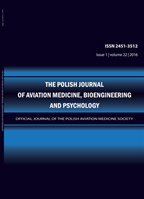2023, Volume 29, Issue 1
WHICH IS THE MOST RELIABLE MARKER TO ASSESS THE EFFECTS OF COSMIC RADIATION EXPOSURE IN POLISH MILITARY PILOTS: A MINI REVIEW OF LITERATURE
KRZYSZTOF KOWALCZUK1, STEFAN P. GAŹDZIŃSKI2, AGATA LEOŃSKA-DUNIEC3, ŁUKASZ DZIUDA4, EWELINA MACULEWICZ5
-------------------------------------------------------------------------------------------------
1Department of Simulator Studies and Aeromedical Training, Military Institute of Aviation Medicine
2Creative Neuroscience Lab – CNS Lab, Military Institute of Aviation Medicine
3Faculty of Physical Education, Gdansk University of Physical Education and Sport
4Department of Psychophysiological Measurements and Human Factor Research, Military Institute of Aviation Medicine
5Faculty of Physical Education, Jozef Pilsudski University of Physical Education in Warsaw
Autor korenspondencyjny: EWELINA MACULEWICZ; Faculty of Physical Education, Jozef Pilsudski University of Physical Education in Warsaw; email: ewelina.maculewicz@awf.edu.pl
Full text
Streszczenie
Abstract: Military pilots, similar to civilian pilots and crew members, receive larger doses of ionizing radiation than the general population. Exposition to small doses of ionizing radiation at prolonged durations has been related to slightly higher incidence of certain cancers. However, fighter jet pilots from time to time flight their airplanes at even higher altitudes, thus exposing themselves to higher doses of more energetic radiation than their civilian counterparts. In this mini review we discuss the procedures involved in controlling the radiation exposure to military and civilian pilots, as well as air crews. Markers of radiation exposure are discussed. Based on available literature, it appears that the biological markers of radiation, i.e., markers related to the actual changes in tissues, account also for individual differences in anatomy and physiology, as well as individual differences in sensitivity and lifestyle, as jet engine emissions, electromagnetic fields from cockpit instruments, ultraviolet radiation, carcadian rhythm disruption, etc.
This mini review concludes that biological dosimetry methods, i.e., counting frequencies of chromosomal aberrations, appears to be most suitable to evaluate exposure to ionizing radiation in military pilots.
Słowa kluczowe
ionizing radiation, military aviation, dicentric chromosome assay
